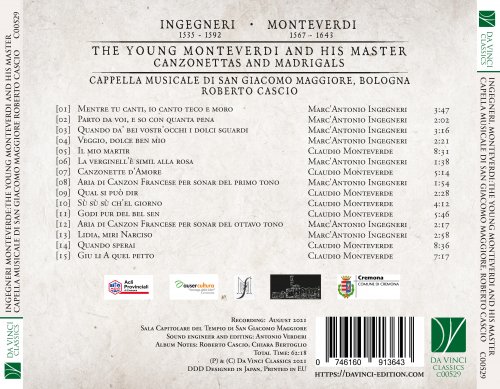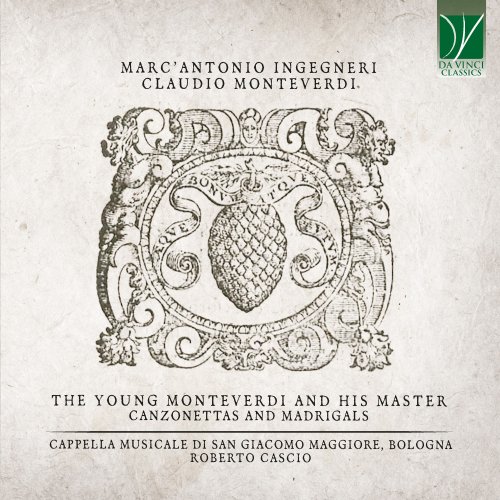
Roberto Cascio, Capella Musicale di San Giacomo Maggiore - The Young Monteverdi and His Master: Canzonettas and Madrigals (2022)
BAND/ARTIST: Roberto Cascio, Capella Musicale di San Giacomo Maggiore
- Title: The Young Monteverdi and His Master: Canzonettas and Madrigals
- Year Of Release: 2022
- Label: Da Vinci Classics
- Genre: Classical
- Quality: flac lossless (tracks)
- Total Time: 01:02:17
- Total Size: 275 mb
- WebSite: Album Preview
Tracklist
01. Il secondo libro de madrigali: No. 4, Mentre tu canti, io canto teco e moro
02. Il secondo libro de madrigali: No. 13, Parto da voi, e so con quanta pena
03. Il secondo libro de madrigali: No. 12, Quando da' bei vostr'occhi i dolci sguardi
04. Il secondo libro de madrigali: No. 18, Veggio, dolce ben mio
05. Canzonette a tre voci, SV 6: No. 6, Il mio martir
06. Il secondo libro de madrigali: No. 3, La verginell'è simil alla rosa
07. Canzonette a tre voci, SV 2: No. 2, Canzonette d'Amore
08. Il secondo libro de madrigali: No. 20, Aria di Canzon Francese per sonar del primo tono
09. Canzonette a tre voci, SV 1: No. 1, Qual si può dir
10. Canzonette a tre voci, SV 9: No. 9, Sù sù sù ch'el giorno
11. Canzonette a tre voci, SV 16: No. 16, Godi pur del bel sen
12. Il secondo libro de madrigali: No. 21, Aria di Canzon Francese per sonar del ottavo tono
13. Il secondo libro de madrigali: No. 15, Lidia, miri Narciso
14. Canzonette a tre voci, SV 10: No. 10, Quando sperai
15. Canzonette a tre voci, SV 17: No. 17, Giu li A quel petto

In Italy, the sixteenth century coincides with both the highest splendour and the gradual fading of the Rinascimento, the unique Italian version of the Renaissance. It included an unparalleled flourishing of the visual arts – from painting to sculpture to architecture, but not limited to these –, the ripening of the humanist movement with its rediscovery of the Classical past and its literary fruits, and an exquisite blossoming of musical genres and works. It was also a deeply contradictory time. Striking inequalities characterized the socioeconomical status of the inhabitants of the peninsula. The extraordinary legacy of the Renaissance in terms of artworks was the paradoxical result of strong rivalries among the cities and states of what is today’s Italy. More significantly, it was a time of saints and sinners, and both in the highest degree: lasciviousness and immorality characterized the lives of many aristocrats and clergy, but, at the same time, great saints such as Carlo Borromeo or Philip Neri were offering new models of holiness, proposing a Catholic response to the abuses denounced by the Protestants, and embodying the spiritual elan of the Council of Trent.
Within this atmosphere, two musicians lived and flourished. Approximately three decades separate the births of Marc’Antonio Ingegneri and of Claudio Monteverdi: the space of a generation characterizes their relationship, very close to that of a father and of a son. Ingegneri was born in Verona. In his teens, he left his family and was admitted to the prestigious Scuola accolitale (acolytes’ school) of the Cathedral, where many of the finest musicians of the time either taught or studied. There, he had the possibility of being exposed to the centuries-old tradition of Franco-Flemish polyphony, but also to familiarize himself with the new, exquisitely Italian trends of word-setting. Ingegneri must have been also a good violin player, as he briefly worked in this capacity in Venice. However, his life would soon turn otherwise; in particular, he was attached to the splendid court of Parma, where Cipriano de Rore (another Flemish composer) was operating. Ingegneri soon demonstrated his talent and skill, publishing his first books of madrigals before or around his thirtieth birthday. At approximately the same time, he moved to Cremona, where his professionality began to properly shine. While successfully establishing himself as a great musician and respected teacher in Cremona, he also maintained ties with the other major cities and courts of northern Italy, as well as with Rome. In his forties, he was appointed praefectus musicus of the Cathedral church, leading various musical ensembles for the worship of the Cathedral, and fostering in particular the increasing use of musical instruments in liturgy. The publication of his sacred works followed that of his secular output: he had no less than five madrigal books printed between 1579 and 1587, and his collections of motets, masses, responsories, lamentations and polychoral works appeared between 1586 and 1591. This mirrors his careful consideration of the dictates of the Tridentine Council and of how they had been interpreted; in turn, this attention was certainly fostered by his closeness with bishop Niccolò Sfondrati, who could become Pope Gregory XIII. In his pontificate, Gregory would commission the revision of the Gregorian repertoire to Palestrina and Zoilo, thus bearing witness to his great attention for the musical aspect of liturgy.
One of the many merits of Ingegneri, and not the least, is to have given impressed the right direction to the first musical studies of young Claudio Monteverdi, who toiled under his guidance in his native city of Cremona. Their relationship must have been fruitful from the musical viewpoint, but also positive in human terms, since the first published works of a teenage Monteverdi explicitly identified the composer as a disciple of Ingegneri. Even though the personality of the young genius is already evident in his first essays, his teacher’s influence is undeniable; the close comparison of their styles, as allowed by this Da Vinci Classics album, fosters a better understanding of both, and promotes our clearer appreciation of their similarities and differences.
01. Il secondo libro de madrigali: No. 4, Mentre tu canti, io canto teco e moro
02. Il secondo libro de madrigali: No. 13, Parto da voi, e so con quanta pena
03. Il secondo libro de madrigali: No. 12, Quando da' bei vostr'occhi i dolci sguardi
04. Il secondo libro de madrigali: No. 18, Veggio, dolce ben mio
05. Canzonette a tre voci, SV 6: No. 6, Il mio martir
06. Il secondo libro de madrigali: No. 3, La verginell'è simil alla rosa
07. Canzonette a tre voci, SV 2: No. 2, Canzonette d'Amore
08. Il secondo libro de madrigali: No. 20, Aria di Canzon Francese per sonar del primo tono
09. Canzonette a tre voci, SV 1: No. 1, Qual si può dir
10. Canzonette a tre voci, SV 9: No. 9, Sù sù sù ch'el giorno
11. Canzonette a tre voci, SV 16: No. 16, Godi pur del bel sen
12. Il secondo libro de madrigali: No. 21, Aria di Canzon Francese per sonar del ottavo tono
13. Il secondo libro de madrigali: No. 15, Lidia, miri Narciso
14. Canzonette a tre voci, SV 10: No. 10, Quando sperai
15. Canzonette a tre voci, SV 17: No. 17, Giu li A quel petto

In Italy, the sixteenth century coincides with both the highest splendour and the gradual fading of the Rinascimento, the unique Italian version of the Renaissance. It included an unparalleled flourishing of the visual arts – from painting to sculpture to architecture, but not limited to these –, the ripening of the humanist movement with its rediscovery of the Classical past and its literary fruits, and an exquisite blossoming of musical genres and works. It was also a deeply contradictory time. Striking inequalities characterized the socioeconomical status of the inhabitants of the peninsula. The extraordinary legacy of the Renaissance in terms of artworks was the paradoxical result of strong rivalries among the cities and states of what is today’s Italy. More significantly, it was a time of saints and sinners, and both in the highest degree: lasciviousness and immorality characterized the lives of many aristocrats and clergy, but, at the same time, great saints such as Carlo Borromeo or Philip Neri were offering new models of holiness, proposing a Catholic response to the abuses denounced by the Protestants, and embodying the spiritual elan of the Council of Trent.
Within this atmosphere, two musicians lived and flourished. Approximately three decades separate the births of Marc’Antonio Ingegneri and of Claudio Monteverdi: the space of a generation characterizes their relationship, very close to that of a father and of a son. Ingegneri was born in Verona. In his teens, he left his family and was admitted to the prestigious Scuola accolitale (acolytes’ school) of the Cathedral, where many of the finest musicians of the time either taught or studied. There, he had the possibility of being exposed to the centuries-old tradition of Franco-Flemish polyphony, but also to familiarize himself with the new, exquisitely Italian trends of word-setting. Ingegneri must have been also a good violin player, as he briefly worked in this capacity in Venice. However, his life would soon turn otherwise; in particular, he was attached to the splendid court of Parma, where Cipriano de Rore (another Flemish composer) was operating. Ingegneri soon demonstrated his talent and skill, publishing his first books of madrigals before or around his thirtieth birthday. At approximately the same time, he moved to Cremona, where his professionality began to properly shine. While successfully establishing himself as a great musician and respected teacher in Cremona, he also maintained ties with the other major cities and courts of northern Italy, as well as with Rome. In his forties, he was appointed praefectus musicus of the Cathedral church, leading various musical ensembles for the worship of the Cathedral, and fostering in particular the increasing use of musical instruments in liturgy. The publication of his sacred works followed that of his secular output: he had no less than five madrigal books printed between 1579 and 1587, and his collections of motets, masses, responsories, lamentations and polychoral works appeared between 1586 and 1591. This mirrors his careful consideration of the dictates of the Tridentine Council and of how they had been interpreted; in turn, this attention was certainly fostered by his closeness with bishop Niccolò Sfondrati, who could become Pope Gregory XIII. In his pontificate, Gregory would commission the revision of the Gregorian repertoire to Palestrina and Zoilo, thus bearing witness to his great attention for the musical aspect of liturgy.
One of the many merits of Ingegneri, and not the least, is to have given impressed the right direction to the first musical studies of young Claudio Monteverdi, who toiled under his guidance in his native city of Cremona. Their relationship must have been fruitful from the musical viewpoint, but also positive in human terms, since the first published works of a teenage Monteverdi explicitly identified the composer as a disciple of Ingegneri. Even though the personality of the young genius is already evident in his first essays, his teacher’s influence is undeniable; the close comparison of their styles, as allowed by this Da Vinci Classics album, fosters a better understanding of both, and promotes our clearer appreciation of their similarities and differences.
Year 2022 | Classical | FLAC / APE
As a ISRA.CLOUD's PREMIUM member you will have the following benefits:
- Unlimited high speed downloads
- Download directly without waiting time
- Unlimited parallel downloads
- Support for download accelerators
- No advertising
- Resume broken downloads


